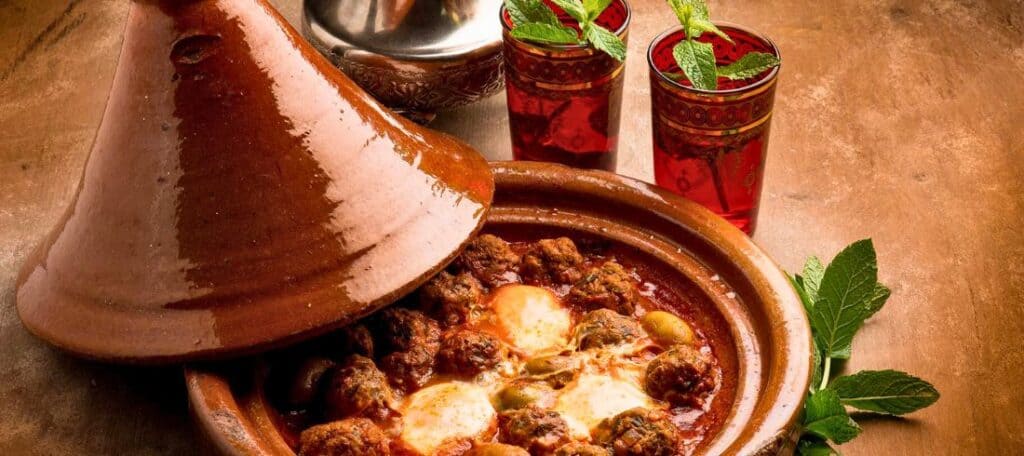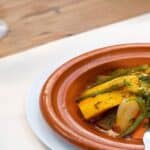
Moroccan cuisine is a treasure trove of delightful flavors and unique culinary traditions. Influenced by Berber, Andalusian, Mediterranean, and Arab cultures, Moroccan dishes are a fusion of diverse tastes and ingredients that truly tantalize the taste buds. From aromatic tagines and fluffy couscous to savory pastillas and indulgent desserts, Moroccan cuisine has something to offer for every food lover.
One of the hallmarks of Moroccan cuisine is its rich and complex flavors, achieved through the skilled use of spices and seasonings. Cumin, turmeric, cinnamon, saffron, and paprika are just a few of the spices that lend depth and character to Moroccan dishes. Whether it’s the delicate balance of sweet and savory in a tagine or the burst of vibrant flavors in a couscous dish, the spices play an integral role in creating the distinct Moroccan taste.
Traditional Moroccan meals are a celebration of communal dining and the joy of sharing food with loved ones. The meal often starts with a selection of hot and cold salads, bursting with freshness and a medley of flavors. This is followed by a hearty main course, such as a fragrant tagine or a fluffy mound of couscous topped with tender meat or vegetables. Desserts in Moroccan cuisine are pure indulgence, with treats like gazelle ankles and beghrir satisfying even the most discerning sweet tooth.
Exploring Moroccan cuisine means embarking on a journey of flavors, traditions, and cultural richness. Whether you’re dining at a traditional Moroccan restaurant or trying your hand at cooking authentic Moroccan recipes at home, you’ll be transported to the vibrant streets of Marrakech or the bustling spice markets of Casablanca with every bite.
- Moroccan cuisine is a harmonious fusion of Berber, Andalusian, Mediterranean, and Arab influences.
- Flavorful spices like cumin, turmeric, saffron, and paprika are the soul of Moroccan dishes.
- Traditional Moroccan meals often include a combination of hot and cold salads, followed by main dishes like tagines or couscous.
- Moroccan desserts, such as gazelle ankles and beghrir, offer a delightful end to a meal.
- Whether dining out or cooking at home, experiencing Moroccan cuisine is a journey of tastes, traditions, and cultural exploration.
Traditional Moroccan Dishes :
Moroccan cuisine is renowned for its diverse and flavorful dishes that showcase the unique ingredients and spices of the region. From the hearty couscous to the aromatic tagine and the delicate pastilla, Moroccan cuisine offers a delightful culinary experience. Let’s explore these traditional Moroccan dishes in more detail:
Couscous
Couscous is a staple in Moroccan cuisine and a beloved dish worldwide. Made from tiny semolina grains, couscous is steamed and typically served with a flavorful stew of meat or vegetables. The grains are light and fluffy, providing the perfect base for rich and fragrant flavors.
Tagine
Tagine refers to both the dish and the clay pot it is cooked in. This iconic Moroccan dish is made by slow-cooking meat, vegetables, and aromatic spices in a cone-shaped pot. The result is a tender and succulent dish with a distinctive blend of flavors. Tagine is often served with couscous or crusty bread.
Pastilla
Pastilla, also known as bastilla or b’stilla, is a savory pie that combines sweet and savory flavors in one exquisite dish. It is made by layering thin pastry sheets with a filling of tender pigeon meat, almonds, and aromatic spices such as cinnamon and saffron. The pie is then baked until golden and topped with powdered sugar and more cinnamon.
These traditional Moroccan dishes bring together the rich flavors of Moroccan spices, the freshness of local ingredients, and the masterful techniques of Moroccan cooking. Each dish tells a story of cultural heritage and culinary tradition, making them a must-try for anyone seeking an authentic taste of Morocco.
| Dish | Description |
|---|---|
| Couscous | A hearty dish made with tiny semolina grains and served with a flavorful stew of meat or vegetables. |
| Tagine | A slow-cooked dish made in a clay pot, typically with meat, vegetables, and aromatic spices. |
| Pastilla | A savory pie made with layers of thin pastry filled with a mixture of pigeon meat, almonds, and spices, topped with powdered sugar and cinnamon. |
Moroccan Spices and Flavorings :
Moroccan cuisine is well-known for its extensive use of spices and flavorings, which contribute to its distinctive taste and aroma. The use of these spices adds depth and complexity to Moroccan dishes, making them truly unique. Some of the popular Moroccan spices include:
- Cumin: This aromatic spice adds a warm and earthy flavor to Moroccan dishes. It is often used in meat-based stews, tagines, and couscous.
- Paprika: Paprika brings a mild and slightly sweet flavor to Moroccan cuisine. It is commonly used in spice blends and marinades for meats and vegetables.
- Ginger: With its zesty and pungent taste, ginger is frequently used in Moroccan dishes to add a zingy kick. It works well in both savory and sweet recipes.
- Turmeric: Known for its vibrant golden color, turmeric is used in Moroccan cuisine to lend a warm and slightly bitter flavor to dishes like tagines and rice.
- Coriander: Coriander seeds and leaves are widely used in Moroccan cooking. The seeds have a slightly citrusy and nutty flavor, while the leaves add freshness to dishes.
- Saffron: Saffron is highly prized in Moroccan cuisine for its unique floral aroma and intense yellow color. It is used sparingly in dishes like chicken tagine and seafood paella.
Unique Spice Blend: Ras el Hanout :
A standout spice blend in Moroccan cooking is ras el hanout. This aromatic mixture typically contains a combination of up to 40 different spices, carefully blended to create a rich and complex flavor profile. The exact composition of ras el hanout varies from one spice merchant to another, with each adding their own unique twist. Common ingredients found in ras el hanout include cumin, coriander, ginger, cinnamon, cloves, nutmeg, cardamom, and turmeric. This spice blend is used in a wide range of Moroccan dishes, including meat and vegetable tagines, couscous, and grilled meats. Ras el hanout adds depth and warmth to Moroccan cuisine, enhancing the overall taste of the dish.
Flavorings in Moroccan Cuisine :
In addition to spices, Moroccan cuisine also incorporates various flavorings to enhance its dishes. Some popular flavorings used in Moroccan cooking include:
- Preserved Lemon: Preserved lemons lend a unique tangy and salty flavor to Moroccan dishes. They are made by pickling lemons in a mixture of salt and lemon juice, resulting in a vibrant and flavorful ingredient.
- Argan Oil: Argan oil is a specialty oil made from the kernels of argan trees native to Morocco. It imparts a nutty flavor and is often drizzled over salads, couscous, and grilled vegetables.
- Olive Oil: Olive oil is widely used in Moroccan cuisine for cooking and dressing salads. It adds a fruity and rich flavor to dishes.
- Dried Fruits: Dried fruits like dates, figs, apricots, and raisins are frequently used in Moroccan dishes to add a natural sweetness and chewy texture.
| Spice | Flavor Profile | Common Uses |
|---|---|---|
| Cumin | Warm and earthy | Meat stews, tagines, couscous |
| Paprika | Mild and slightly sweet | Spice blends, marinades |
| Ginger | Zesty and pungent | Savory and sweet recipes |
| Turmeric | Warm and slightly bitter | Tagines, rice dishes |
| Coriander | Citrusy and nutty | Spice blends, fresh leaves in dishes |
| Saffron | Floral and intense | Chicken tagine, seafood dishes |
Conclusion :
Moroccan cuisine is a delightful journey into the country’s vibrant culinary traditions. With its diverse cultural influences, authentic Moroccan cooking offers a unique and flavorful experience that captivates both locals and visitors alike. From the iconic couscous and tantalizing tagine to the exquisite pastilla, every dish reflects the rich heritage and artistry of Moroccan gastronomy.
What sets Moroccan cuisine apart is the skillful use of an array of spices and flavorings that create a symphony of tastes. From the aromatic cumin to the warm notes of paprika, Moroccan spices add depth and complexity to every dish. The legendary ras el hanout, with its blend of up to 40 spices, tantalizes the taste buds and transports you to the bustling spice markets of Morocco.
Whether you indulge in authentic flavors at a Moroccan restaurant or embark on a culinary adventure in your own kitchen, the essence of Moroccan cuisine lies in its ability to bring people together in celebration of good food and time-honored traditions. So, go ahead and explore the magic of Moroccan spices, savor the delectable flavors, and embrace the culinary treasures that await you in the land of the Atlas Mountains and endless culinary delights.
FAQ
What is Moroccan cuisine?
Moroccan cuisine is a vibrant mix of Berber, Andalusian, Mediterranean, and Arab influences. It is known for its flavorful and aromatic dishes that showcase a variety of ingredients.
What are some traditional Moroccan dishes?
Some traditional Moroccan dishes include couscous, tagine, and pastilla.
What is couscous?
Couscous is a popular dish made with tiny semolina grains. It is served with a flavorful stew of meat or vegetables.
What is a tagine?
Tagine is a dish cooked in a clay pot and typically made with meat, vegetables, and aromatic spices.
What is pastilla?
Pastilla is a savory pie made with layers of thin pastry filled with a mixture of pigeon meat, almonds, and spices, topped with powdered sugar and cinnamon.
What spices are commonly used in Moroccan cuisine?
Popular spices in Moroccan cuisine include cumin, paprika, ginger, turmeric, coriander, saffron, and a unique spice blend called ras el hanout.
What is ras el hanout?
Ras el hanout is a unique spice blend made from a combination of up to 40 different spices and commonly used in Moroccan cooking.
What other flavorings are used in Moroccan cuisine?
Other flavorings in Moroccan cuisine include preserved lemon, argan oil, olive oil, and dried fruits.
What makes Moroccan cuisine unique?
Moroccan cuisine is known for its extensive use of spices, flavorful dishes, and diverse cultural influences, creating a distinctive and flavorful dining experience.








